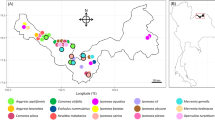Abstract
In this paper, I review pollination systems in which plants provide breeding sites as a reward for pollination. I divide the pollinators into three groups based upon ovipositing sites and the larval food of insects. The first group consists of ovule parasites found in only five plant lineages, e.g., the fig wasps and yucca moths, pollination systems in which pollinator specificity is very high. The second group is pollen parasitism, primarily by thrips (Thysanoptera), but specificity of the pollinators is low. In the third group, pollinator larvae (Coleoptera and Diptera) develop in decomposed flowers and inflorescences of plants and these adaptations evolved repeatedly via different pathways in various plant taxa. Pollinator specificity varies, and shifts in pollinators may occur between related or unrelated insects.
Similar content being viewed by others
Author information
Authors and Affiliations
Additional information
Received: December 26, 2001 / Accepted: January 22, 2002
Rights and permissions
About this article
Cite this article
Sakai, S. A review of brood-site pollination mutualism: plants providing breeding sites for their pollinators. J Plant Res 115, 0161–0168 (2002). https://doi.org/10.1007/s102650200021
Issue Date:
DOI: https://doi.org/10.1007/s102650200021




